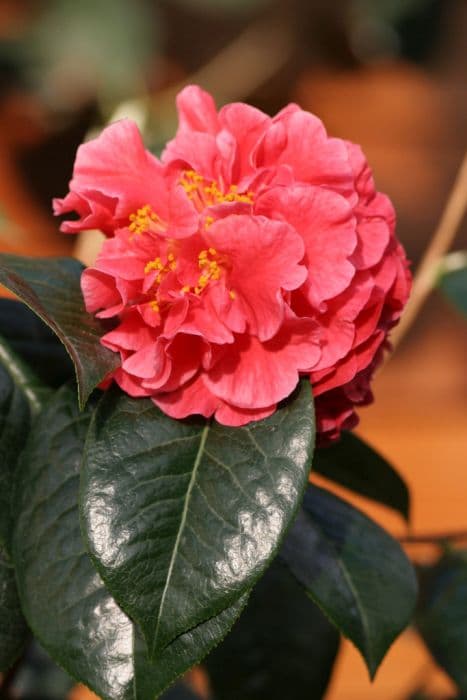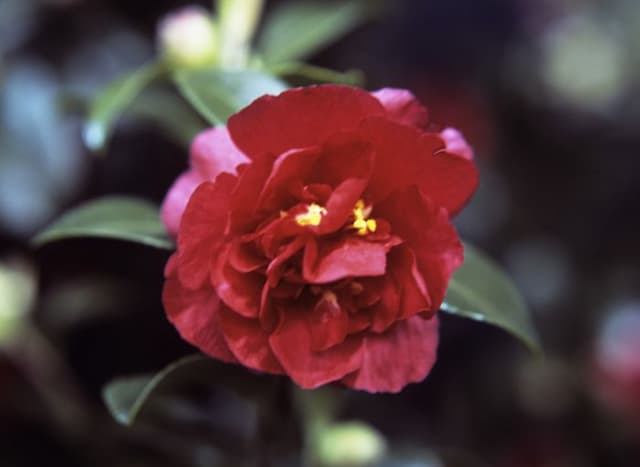Silky Camellia Stewartia malacodendron

ABOUT
The plant in question, commonly known as the silky camellia, boasts a captivating display with its ornamental features. It is adorned with striking white flowers that possess a gentle, silky texture, from which it derives its name. The blooms are particularly noted for their prominent central cluster of yellow stamens, which stand out against the creaminess of the petals, adding to the visual allure. These flowers provide a contrast to the dark green foliage, which is glossy and has a leathery touch. Each leaf presents an elliptical shape, with edges that are finely toothed, providing a subtle textural interest. The overall appearance is one of elegance and delicate beauty, with the flowers appearing to glow amidst the greenery during its blooming season. The bark of the silky camellia adds to its ornamental value, with an exfoliating nature that reveals a range of colors beneath, from grays to rich browns, giving the plant year-round interest even when not in bloom. The form of the plant is typically multi-stemmed, lending itself to a graceful structure that further enhances its garden appeal.
About this plant
 Names
NamesFamily
Theaceae
Synonyms
Silky Camellia, Virginia Stewartia, Silky Stewartia
Common names
Hartia malacodendron, Malachodendron ovatum, Stewartia ovata, Stewartia vernalis.
 Toxicity
ToxicityTo humans
The Stewartia malacodendron, commonly known as Silky Camellia, is not widely recognized as a toxic plant to humans. There is no well-documented evidence of toxicity, and it isn't typically listed among plants that cause poisoning when ingested. However, as with any plant, individual allergies or sensitivities could potentially cause adverse reactions, and it is generally advisable to avoid consuming parts of ornamental plants due to potential unknowns in their chemical makeup.
To pets
Similar to its effects on humans, the Silky Camellia is not commonly known to be toxic to pets. There's no significant evidence to suggest that animals, such as dogs and cats, would be poisoned by ingesting parts of this plant. As always, it is best to prevent pets from eating ornamental plants, as they can sometimes have unexpected reactions or may cause gastrointestinal discomfort due to the fibre and compounds they are not accustomed to digesting.
 Characteristics
CharacteristicsLife cycle
Perennials
Foliage type
Deciduous
Color of leaves
Green
Flower color
White
Height
10-20 feet (3-6 meters)
Spread
8-15 feet (2.4-4.5 meters)
Plant type
Tree
Hardiness zones
5-8
Native area
Southeastern United States
Benefits
 General Benefits
General Benefits- Ornamental Value: Stewartia malacodendron, also known as silky camellia, has beautiful white flowers with purple anthers that enhance the visual appeal of gardens and landscapes.
- Habitat Support: Silky camellia provides habitat and nesting sites for various bird species and other wildlife.
- Seasonal Interest: It offers year-round interest with its showy flowers in summer and colorful foliage in autumn.
- Pollinator Attraction: The flowers attract bees and other pollinators, supporting local ecosystems.
- Shade Production: Being a tree, silky camellia can provide shade which can help in reducing local temperature and offering a cooler environment.
- Drought Resistance: Once established, silky camellia has good drought tolerance, making it suitable for xeriscaped gardens.
- Erosion Control: Its root system can help stabilize the soil, preventing erosion in hilly or sloped areas.
- Cultural Significance: In certain cultures, the plant is valued for its aesthetic and is often used in traditional garden designs.
- Privacy Screen: When planted in groups, silky camellia can offer privacy as a natural screen or hedge.
- Woodworking Material: The wood of silky camellia is hard and fine-grained, making it suitable for specialty woodworking projects.
 Medical Properties
Medical PropertiesThis plant is not used for medical purposes.
 Air-purifying Qualities
Air-purifying QualitiesThis plant is not specifically known for air purifying qualities.
 Other Uses
Other Uses- The wood of the Silky Camellia is occasionally used in fine woodworking for its smooth texture and can be crafted into specialty items like inlays or small wooden boxes.
- The bark has been used historically for tanning leather due to the presence of tannins.
- In landscape design, the Silky Camellia is employed as a specimen tree for its attractive flowers and striking bark texture.
- The seed pods can be used in floral arrangements as a unique textural element.
- Its slow growth and dense foliage make Silky Camellia suitable for bonsai cultivation.
- The dried leaves of the Silky Camellia can be incorporated into potpourris for their subtle aesthetic appeal.
- Photographers and artists sometimes use the beautiful form and flowers of the plant as a subject in their work.
- Crafted fallen branches and unusual seed pods can be repurposed into natural jewelry pieces, like pendants or earrings.
- The plant's natural resistance to pests makes it a good candidate for organic gardening without needing synthetic pesticides.
- Due to its relatively rare status, Silky Camellia is sometimes used in conservation education programs to highlight the importance of preserving native plant species.
Interesting Facts
 Feng Shui
Feng ShuiThe Stewartia is not used in Feng Shui practice.
 Zodiac Sign Compitability
Zodiac Sign CompitabilityThe Stewartia is not used in astrology practice.
 Plant Symbolism
Plant Symbolism- Elegance - Stewartia, commonly known as "Stewartia," often symbolizes elegance due to its delicate, showy flowers and graceful form.
- Beauty in solitude - Due to its preference for growing in quiet wooded areas, Stewartia can represent the beauty found in solitude and peaceful surroundings.
- Adaptability - With its ability to grow in various soil conditions, Stewartia represents adaptability and resilience in changing environments.
- Change - The transformation of its leaves from green to vibrant hues in the fall can symbolize change and embracing new life cycles.
 Water
WaterSilk tree Stewartia needs consistent moisture, especially during its growing season in the spring and summer. It is important to maintain a regular watering schedule, usually watering deeply once a week. The soil should be kept moist but not waterlogged, and it's critical to ensure proper drainage to avoid root rot. During the hotter months or periods of drought, increase watering to twice a week, providing about 1-2 gallons per session depending on the size and maturity of the plant. In the cooler seasons, reduce watering to every other week or when the top inch of soil feels dry to the touch.
 Light
LightSilk tree Stewartia prefers partial shade to full sun conditions. The ideal spot would provide morning sunlight with some afternoon shade or dappled sunlight throughout the day. Too much direct, hot sun may scorch the leaves, and too much shade can lead to fewer flowers, so finding a balance is important for the health and aesthetics of the plant.
 Temperature
TemperatureSilk tree Stewartia thrives in temperatures ranging from 60 to 80°F and can withstand minimum temperatures down to 10°F for brief periods. However, prolonged exposure to temperatures below freezing can be detrimental to the plant. The ideal growing conditions are in USDA Hardiness Zones 5 through 8, where seasonal temperature variations align well with the plant's needs.
 Pruning
PruningSilk tree Stewartia should be pruned to maintain its shape and to remove any dead or damaged branches. Pruning is best done in late winter or early spring before new growth begins. It may also be necessary to remove any suckers or unwanted shoots at the base to retain a single trunk or desired form. Major pruning should be done infrequently, as the plant does not respond well to heavy cutting.
 Cleaning
CleaningAs needed
 Soil
SoilSilky Camellia thrives in acidic soil with a pH of 5.0 to 6.5. The best soil mix should be rich in organic matter, such as well-rotted leaf mold or compost, and have good drainage. A mixture of equal parts loam, peat, and perlite or pine bark can provide the necessary conditions for healthy growth.
 Repotting
RepottingSilky Camellia should be repotted once every 2 to 3 years or when it outgrows its current pot. It's best to repot in the spring before new growth begins. Use a slightly larger pot with fresh acidic soil mix to encourage health and growth.
 Humidity & Misting
Humidity & MistingSilky Camellia prefers moderate to high humidity levels, ideally between 40-60%. If indoor air is too dry, consider using a humidifier or placing the pot on a tray of wet pebbles to increase humidity around the plant.
 Suitable locations
Suitable locationsIndoor
Provide bright, indirect light and keep evenly moist.
Outdoor
Plant in partial shade with well-draining acidic soil.
Hardiness zone
7-9 USDA
 Life cycle
Life cycleThe life of the Stewartia malacodendron, commonly known as the Silky Camellia, begins with seed germination, which is dependent on a warm stratification period. After germination, the seedling develops a taproot and begins to grow its first true leaves, entering the juvenile phase. The plant continues to grow, producing a woody stem and branching out to form its characteristic shape. It reaches maturity in several years, when it starts flowering in the summer, displaying white blossoms with purple stamens that are pollinated by insects. The pollinated flowers then develop into seed capsules, which upon maturing, release seeds to start the next generation. Throughout the life cycle, the Silky Camellia undergoes seasonal changes with leaf fall in the winter and new growth in the spring.
 Propogation
PropogationPropogation time
Spring-Early Summer
Propogation: The most popular method of propagating the Stewartia malacodendron, also known as the silky camellia, involves the use of seeds. The best time to collect seeds is when the fruit naturally splits open, typically in the fall. To prepare for sowing, the seeds should be cleaned and then stratified, which means exposing them to cold temperatures to mimic winter conditions—this process can take several months. After stratification, the seeds are sown in a well-draining soil mix, and kept moist until germination, which can be slow and inconsistent. It's important to provide the emerging seedlings with protection from direct sunlight and extreme temperatures to ensure successful growth.









